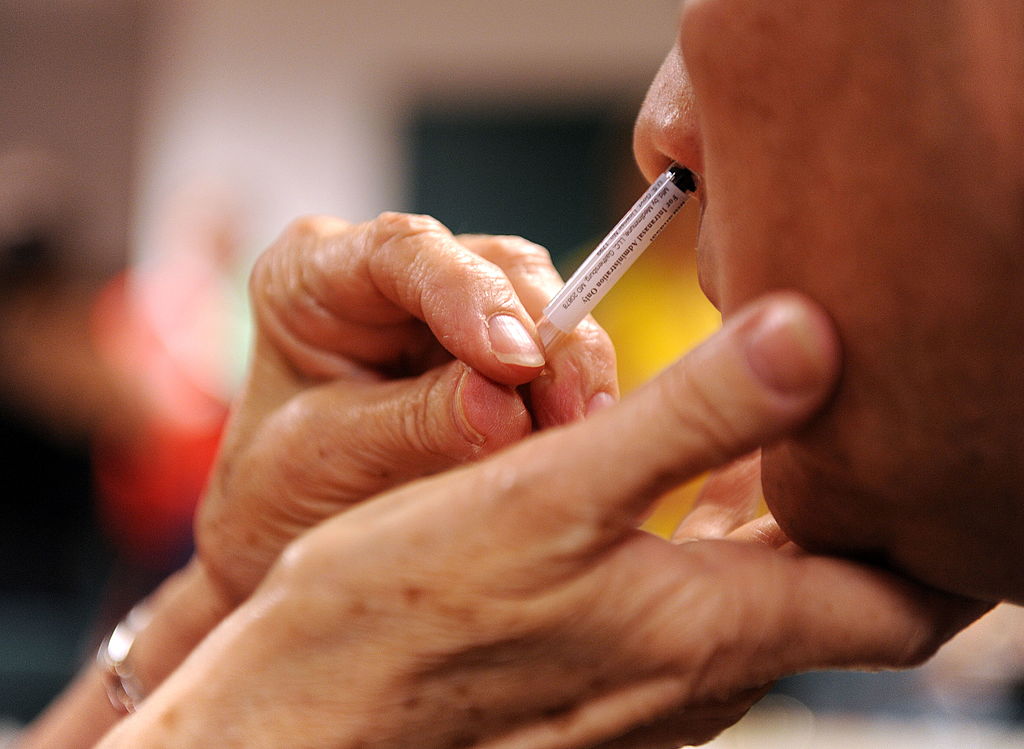The potential benefits of an 'intranasal' COVID vaccine


Get those tissues ready.
A COVID-19 vaccine that's nasally administered — rather than shot into the arm — could provide heightened upper respiratory protection, Stat News reported Tuesday.
Intramuscular injections are still a "spectacular" line of defense, Stat writes, but they do not provide the "sterilizing immunity" needed to block all infection in nasal passages. Of course, like any vaccine, one that's nasally-administered is unlikely to block all COVID infection, but experts say it could do a "better job" than existing ones "by better protecting mucus membranes of the nose and throat."
The Week
Escape your echo chamber. Get the facts behind the news, plus analysis from multiple perspectives.

Sign up for The Week's Free Newsletters
From our morning news briefing to a weekly Good News Newsletter, get the best of The Week delivered directly to your inbox.
From our morning news briefing to a weekly Good News Newsletter, get the best of The Week delivered directly to your inbox.
Moreover, an intranasal vaccine wouldn't require a syringe, cutting both cost and medical waste, nor would it likely necessitate an administering health care professional, writes Stat. Plus, an intranasal inoculation is usually easier to offer to young kids and those with a fear of needles.
All that said, the development of such a tool might be far off. It's not yet clear if the mRNA vaccines could be reformulated, and an intranasal candidate is likely to be a "next, next, next-gen vaccine," adds Florian Krammer, a vaccinologist at the Icahn School of Medicine at Mount Sinai Hospital. Funding is reportedly also an issue.
"It may be possible but would take a lot of work and may require some new innovations," said Barney Graham, who led the team at the National Institute of Allergy and Infectious Diseases that designed the Moderna vaccine. "There are other groups working on it."
A free daily email with the biggest news stories of the day – and the best features from TheWeek.com
Brigid Kennedy worked at The Week from 2021 to 2023 as a staff writer, junior editor and then story editor, with an interest in U.S. politics, the economy and the music industry.
-
 Political cartoons for January 4
Political cartoons for January 4Cartoons Sunday's political cartoons include a resolution to learn a new language, and new names in Hades and on battleships
-
 The ultimate films of 2025 by genre
The ultimate films of 2025 by genreThe Week Recommends From comedies to thrillers, documentaries to animations, 2025 featured some unforgettable film moments
-
 Political cartoons for January 3
Political cartoons for January 3Cartoons Saturday's political cartoons include citizen journalists, self-reflective AI, and Donald Trump's transparency
-
 Blue Origin launches Mars probes in NASA debut
Blue Origin launches Mars probes in NASA debutSpeed Read The New Glenn rocket is carrying small twin spacecraft toward Mars as part of NASA’s Escapade mission
-
 Dinosaurs were thriving before asteroid, study finds
Dinosaurs were thriving before asteroid, study findsSpeed Read The dinosaurs would not have gone extinct if not for the asteroid
-
 SpaceX breaks Starship losing streak in 10th test
SpaceX breaks Starship losing streak in 10th testspeed read The Starship rocket's test flight was largely successful, deploying eight dummy satellites during its hour in space
-
 Rabbits with 'horns' sighted across Colorado
Rabbits with 'horns' sighted across Coloradospeed read These creatures are infected with the 'mostly harmless' Shope papilloma virus
-
 Lithium shows promise in Alzheimer's study
Lithium shows promise in Alzheimer's studySpeed Read Potential new treatments could use small amounts of the common metal
-
 Scientists discover cause of massive sea star die-off
Scientists discover cause of massive sea star die-offSpeed Read A bacteria related to cholera has been found responsible for the deaths of more than 5 billion sea stars
-
 'Thriving' ecosystem found 30,000 feet undersea
'Thriving' ecosystem found 30,000 feet underseaSpeed Read Researchers discovered communities of creatures living in frigid, pitch-black waters under high pressure
-
 New York plans first nuclear plant in 36 years
New York plans first nuclear plant in 36 yearsSpeed Read The plant, to be constructed somewhere in upstate New York, will produce enough energy to power a million homes
